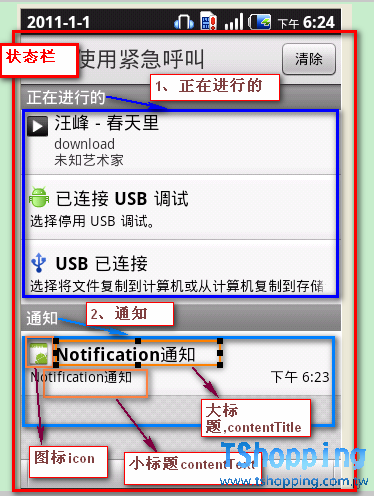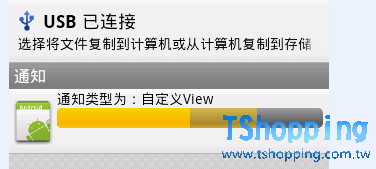Notification ——通知,是一種讓你的應用程序在不使用Activity的情況下警示用戶。它是看不見的程序組件(Broadcast Receiver,Service和不活躍的Activity) 警示用戶有需要注意的事件發生的最好途徑。Notification是由NotificationManager(系統服務)統一管理的。
一般來說, 一個Notification應該傳送的消息包括: 1 、一個狀態條圖標 2、在拉伸的狀態欄窗口中顯示額外的信息和啟動一個Application的Intent 3、閃燈或LED 4、電話震動 在狀態欄(Status Bar)中,通知主要有兩類(使用FLAG_標記,後面講解到): 1、正在運行的事件 2、通知事件
Notification圖解如下:  通知瑞凱紹: 常量: //表示發送一個Notification的所攜帶的效果 DEFAULT_ALL 使用默認字段 DEFAULT_LIGHTS 默認閃光 DEFAULT_SOUND 默認聲音(uri,指向路徑) DEFAULT_VIRATE默認震動,後來得知需要添加震動權限VIBRATE: android.permission.VIBRATE
PS:以上的效果常量可以累加,即通過mNotifaction.defaults |=DEFAULT_SOUND (有些效果只能在真機上才有,比如震動) //設置Flag位 FLAG_AUTO_CANCEL 該通知能被狀態欄的清除按鈕給清除掉 FLAG_NO_CLEAR 該通知不能被狀態欄的清除按鈕給清除掉 FLAG_ONGOING_EVENT 通知放置在正在運行 常用字段 contentView 通知在狀態欄的顯示View(自定義,具體請看下文) ,常與contentIntent配合使用,點擊該通知後, 即觸發contentIntent contentIntent 設置PendingIntent對象,點擊該通知時發送該Intent flags 設置flag位,例如FLAG_NO_CLEAR等 defaults 添加效果 tickerText 顯示在狀態欄中的文字 when 發送此通知的時間戳 icon 設置圖標 常用方法介紹: 無效setLatestEventInfo(上下文語境,CharSequence的contentTitle,CharSequence的contentText,PendingIntent contentIntent) 功能: 顯示在拉伸狀態欄中的Notification屬性,點擊後將發送PendingIntent對象。 參數: context 上下文環境 contentTitle 狀態欄中的大標題 contentText 狀態欄中的小標題 contentIntent 點擊後將發送PendingIntent對象 另外的就是Notification的幾步不同構造方法了,其構造方法的參數含義如上,請參考SDK 。 注意,關於通知(Notification)的顯示類型有兩種: 第一種:使用默認的形式(效果圖如上顯示)。具體使用是為Notification對象設置setLatestEventInfo()方法(該方法內部創建了默認的RemoteViews對象,因此為默認顯示),否則程序會報異常; 第二種:使用自定義的View(RemoteViews對象)顯示 (功能更加自由,強大),具體方法為設置Notification對象的 contentView屬性和contentIntent屬性,此時不需要設置setLatestEventInfo()方法。具體使用方法如下: - Notification noti = new Notification(icon, title, when + 10000);
- noti.flags = Notification.FLAG_INSISTENT;
- // 1、創建一個自定義的消息佈局
- notification.xml
- // 2、在程序代碼中使用RemoteViews的方法來定義image和text。
- 然後把RemoteViews對像傳到contentView字段
- RemoteViews remoteView = new RemoteViews(this.getPackageName(),R.layout.notification); remoteView.setImageViewResource(R.id.image, R.drawable.icon); remoteView.setTextViewText(R.id.text , "Hello,this message is in a custom expanded view");
- noti.contentView = remoteView;
- // 3、為Notification的contentIntent字段定義一個Intent(注意,使用自定義View不需要setLatestEventInfo()方法)
- //這兒點擊後簡答啟動Settings模塊
- PendingIntent contentIntent = PendingIntent.getActivity(MainActivity.this, 0,new Intent("android.settings.SETTINGS"), 0); noti.contentIntent = contentIntent;
本文采用的RemoteViews資源文件如下:/layout/notification.xml - <?xml version="1.0" encoding="utf-8"?>
- <RelativeLayout xmlns:android="http://schemas.android.com/apk/res/android"
- android:orientation="horizontal" android:layout_width="fill_parent"
- android:layout_height="fill_parent">
- <ImageView android:id="@+id/image" android:layout_width="wrap_content"
- android:layout_height="fill_parent" />
- <TextView android:id="@+id/text" android:layout_width="wrap_content"
- android:layout_toRightOf="@+id/image"
- android:layout_height="wrap_content" android:textColor="#000" />
- <ProgressBar android:id="@+id/progress_horizontal"
- style="?android:attr/progressBarStyleHorizontal"
- android:layout_below="@+id/text"
- android:layout_toRightOf="@+id/image"
- android:layout_width="fill_parent" android:layout_height="wrap_content"
- android:max="100" android:progress="50" android:secondaryProgress="75" />
- </RelativeLayout>
效果圖如下:  前面我們說過,NotificationManager是所有Notification的大管家,它的主要職責是加入/移除Notification。 NotificationManager類 通過獲取系統服務來獲取該對象: NotificationManager mNotificationManager =(NotificationManager)getSystemServic(Context.NOTIFICATION_SERVICE); 常用方法: public void cancelAll() 移除所有通知(只是針對當前Context下的Notification) public void cancel (int id)移除標記為id的通知(只是針對當前Context下的所有Notification) 公共無效通知(字符串標記,INT ID,通知通告)將通知加入狀態欄,標籤為標籤,標記為ID 公共無效通知(INT ID,通知通告)將通知加入狀態欄,,標記為ID Demo如下: 說明:示例Demo演示了創建兩種不同類型的Notification ,實現起來也是很簡單的。其實說到兩種不同類型的使用 方式,其實內部原理是差不多的。
PS : 自定義Notification復用了文章之前的佈局文件,請知曉。 - package com.feixun.qin;
- import android.app.Activity;
- import android.app.Notification;
- import android.app.NotificationManager;
- import android.app.PendingIntent;
- import android.content.BroadcastReceiver;
- import android.content.Context;
- import android.content.Intent;
- import android.content.IntentFilter;
- import android.net.Uri;
- import android.os.Bundle;
- import android.provider.MediaStore.Audio;
- import android.util.Log;
- import android.view.View;
- import android.widget.Button;
- import android.widget.RemoteViews;
- import android.widget.RemoteViews.RemoteView;
- public class MainActivity extends Activity {
- private Button sendNotiBt;
- private int count = 0;
- /** Called when the activity is first created. */
- @Override
- public void onCreate(Bundle savedInstanceState) {
- super.onCreate(savedInstanceState);
- setContentView(R.layout.main);
- sendNotiBt = (Button) findViewById(R.id.sendNotiBt);
- sendNotiBt.setOnClickListener(new View.OnClickListener() {
- @Override
- public void onClick(View v) {
- // TODO Auto-generated method stub
- showDefaultNotification();
- }
- });
- }
- //自定義顯示的通知,創建RemoteView對象
- private void showCustomizeNotification() {
- CharSequence title = "i am new";
- int icon = R.drawable.icon;
- long when = System.currentTimeMillis();
- Notification noti = new Notification(icon, title, when + 10000);
- noti.flags = Notification.FLAG_INSISTENT;
- // 1、創建一個自定義的消息佈局view.xml
- // 2、在程序代碼中使用RemoteViews的方法來定義image和text。然後把RemoteViews對像傳到contentView字段
- RemoteViews remoteView = new RemoteViews(this.getPackageName(),R.layout.notification);
- remoteView.setImageViewResource(R.id.image, R.drawable.icon);
- remoteView.setTextViewText(R.id.text , "通知類型為:自定義View");
- noti.contentView = remoteView;
- // 3、為Notification的contentIntent字段定義一個Intent(注意,使用自定義View不需要setLatestEventInfo()方法)
- //這兒點擊後簡單啟動Settings模塊
- PendingIntent contentIntent = PendingIntent.getActivity(MainActivity.this, 0,new Intent("android.settings.SETTINGS"), 0);
- noti.contentIntent = contentIntent;
- NotificationManager mnotiManager = (NotificationManager)getSystemService(Context.NOTIFICATION_SERVICE);
- mnotiManager.notify(0, noti);
- }
- // 默認顯示的的Notification
- private void showDefaultNotification() {
- // 定義Notication的各種屬性
- CharSequence title = "i am new";
- int icon = R.drawable.icon;
- long when = System.currentTimeMillis();
- Notification noti = new Notification(icon, title, when + 10000);
- noti.flags = Notification.FLAG_INSISTENT;
- // 創建一個通知
- Notification mNotification = new Notification();
- // 設置屬性值
- mNotification.icon = R.drawable.icon;
- mNotification.tickerText = "NotificationTest";
- mNotification.when = System.currentTimeMillis(); // 立即發生此通知
- // 帶參數的構造函數,屬性值如上
- // Notification mNotification = = new Notification(R.drawable.icon,"NotificationTest", System.currentTimeMillis()));
- // 添加聲音效果
- mNotification.defaults |= Notification.DEFAULT_SOUND;
- // 添加震動,後來得知需要添加震動權限: Virbate Permission
- //mNotification.defaults |= Notification.DEFAULT_VIBRATE ;
- //添加狀態標誌
- //FLAG_AUTO_CANCEL 該通知能被狀態欄的清除按鈕給清除掉
- //FLAG_NO_CLEAR 該通知能被狀態欄的清除按鈕給清除掉
- //FLAG_ONGOING_EVENT 通知放置在正在運行
- //FLAG_INSISTENT 通知的音樂效果一直播放
- mNotification.flags = Notification.FLAG_INSISTENT ;
- //將該通知顯示為默認View
- PendingIntent contentIntent = PendingIntent.getActivity (MainActivity.this, 0,new Intent("android.settings.SETTINGS"), 0);
- mNotification.setLatestEventInfo(MainActivity.this, "通知類型:默認View", "一般般喲。。。。",contentIntent);
-
- // 設置setLatestEventInfo方法,如果不設置會App報錯異常
- NotificationManager mNotificationManager = (NotificationManager) getSystemService(Context.NOTIFICATION_SERVICE);
-
- //註冊此通知
- // 如果該NOTIFICATION_ID的通知已存在,會顯示最新通知的相關信息,比如tickerText 等
- mNotificationManager.notify(2, mNotification);
- }
- private void removeNotification()
- {
- NotificationManager mNotificationManager = (NotificationManager) getSystemService(Context.NOTIFICATION_SERVICE);
- // 取消的只是當前Context的Notification
- mNotificationManager.cancel(2);
- }
- }
|